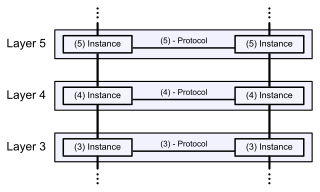
The Open Systems Interconnection (OSI) model is a reference model from the International Organization for Standardization (ISO) that "provides a common basis for the coordination of standards development for the purpose of systems interconnection." In the OSI reference model, the communications between systems are split into seven different abstraction layers: Physical, Data Link, Network, Transport, Session, Presentation, and Application.
A network switch is networking hardware that connects devices on a computer network by using packet switching to receive and forward data to the destination device.
The Common Management Information Protocol (CMIP) is the OSI specified network management protocol.
Manufacturing Message Specification (MMS) is an international standard dealing with messaging systems for transferring real time process data and supervisory control information between networked devices or computer applications. The standard is developed and maintained by the ISO Technical Committee 184 (TC184). MMS defines the following
lwIP is a widely used open-source TCP/IP stack designed for embedded systems. lwIP was originally developed by Adam Dunkels at the Swedish Institute of Computer Science and is now developed and maintained by a worldwide network of developers.

Argus – the Audit Record Generation and Utilization System is the first implementation of network flow monitoring, and is an ongoing open source network flow monitor project. Started by Carter Bullard in 1984 at Georgia Tech, and developed for cyber security at Carnegie Mellon University in the early 1990s, Argus has been an important contributor to Internet cyber security technology over its 30 years..
System Architecture Evolution (SAE) is the core network architecture of mobile communications protocol group 3GPP's LTE wireless communication standard.
Solaris network virtualization and resource control is a set of features originally developed by Sun Microsystems as the OpenSolaris Crossbow umbrella project, providing an internal network virtualization and quality of service framework within the Solaris Operating System.

Junos OS is a FreeBSD-based network operating system used in Juniper Networks routing, switching and security devices.
Security information and event management (SIEM) is a field within the field of computer security, where software products and services combine security information management (SIM) and security event management (SEM). SIEM is the core component of any typical Security Operations Center (SOC), which is the centralized response team addressing security issues within an organization.
In digital communications networks, packet processing refers to the wide variety of algorithms that are applied to a packet of data or information as it moves through the various network elements of a communications network. With the increased performance of network interfaces, there is a corresponding need for faster packet processing.
Software-defined networking (SDN) is an approach to network management that enables dynamic and programmatically efficient network configuration to improve network performance and monitoring in a manner more akin to cloud computing than to traditional network management. SDN is meant to improve the static architecture of traditional networks and may be employed to centralize network intelligence in one network component by disassociating the forwarding process of network packets from the routing process. The control plane consists of one or more controllers, which are considered the brains of the SDN network, where the whole intelligence is incorporated. However, centralization has certain drawbacks related to security, scalability and elasticity.

i3 is a tiling window manager designed for X11, inspired by wmii and written in C. It supports tiling, stacking, and tabbing layouts, which are handled manually. Its configuration is achieved via a plain text file and extending i3 is possible using its Unix domain socket and JSON based IPC interface from many programming languages.

Stack lights are commonly used on equipment in industrial manufacturing and process control environments to provide visual and audible indicators of a machine's status to machine operators, technicians, production managers and factory personnel. They are a form of andon: a manufacturing system that identifies errors as they happen.
Software-defined storage (SDS) is a marketing term for computer data storage software for policy-based provisioning and management of data storage independent of the underlying hardware. Software-defined storage typically includes a form of storage virtualization to separate the storage hardware from the software that manages it. The software enabling a software-defined storage environment may also provide policy management for features such as data deduplication, replication, thin provisioning, snapshots and backup.
Network functions virtualization (NFV) is a network architecture concept that leverages IT virtualization technologies to virtualize entire classes of network node functions into building blocks that may connect, or chain together, to create and deliver communication services.
ViPR Controller is a software-defined storage offering from EMC Corporation announced on May 6, 2013, at EMC World. ViPR abstracts storage from disparate arrays into a single pool of storage capacity that "makes it easier to manage and automate its own data-storage devices and those made by competitors." ViPR became generally available September 27, 2013.
In the fields of Information Technology (IT) and Systems Management, IT operations analytics (ITOA) is an approach or method to retrieve, analyze, and report data for IT operations. ITOA may apply big data analytics to large datasets to produce business insights. In 2014, Gartner predicted its use might increase revenue or reduce costs. By 2017, it predicted that 15% of enterprises will use IT operations analytics technologies.
The OpenDataPlane (ODP) is an open-source project which defines application programming interfaces (APIs) for portable high performance networking data plane applications. ODP API design enables various implementation strategies without exposing the application to implementation details. This allows the same application (source code or binary) to run efficiently on various hardware platforms with different levels of HW acceleration. For example, the same application source code may be re-compiled to run on a standard server system or a specialized networking System on a Chip (SoC) device.
Avi Networks is a company that provides software for the delivery of enterprise applications in data centers and clouds. Acquired by VMware in 2019, Avi Networks provides application services including local and global load balancing, application acceleration, security, application visibility, performance monitoring, service discovery, and container networking services. The company is headquartered in Santa Clara, California and has R&D, support, engineering, and sales offices in Europe and Asia.




